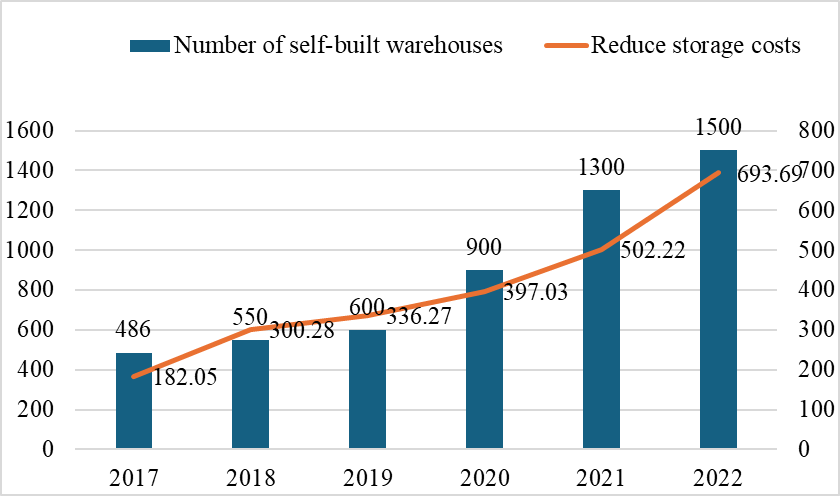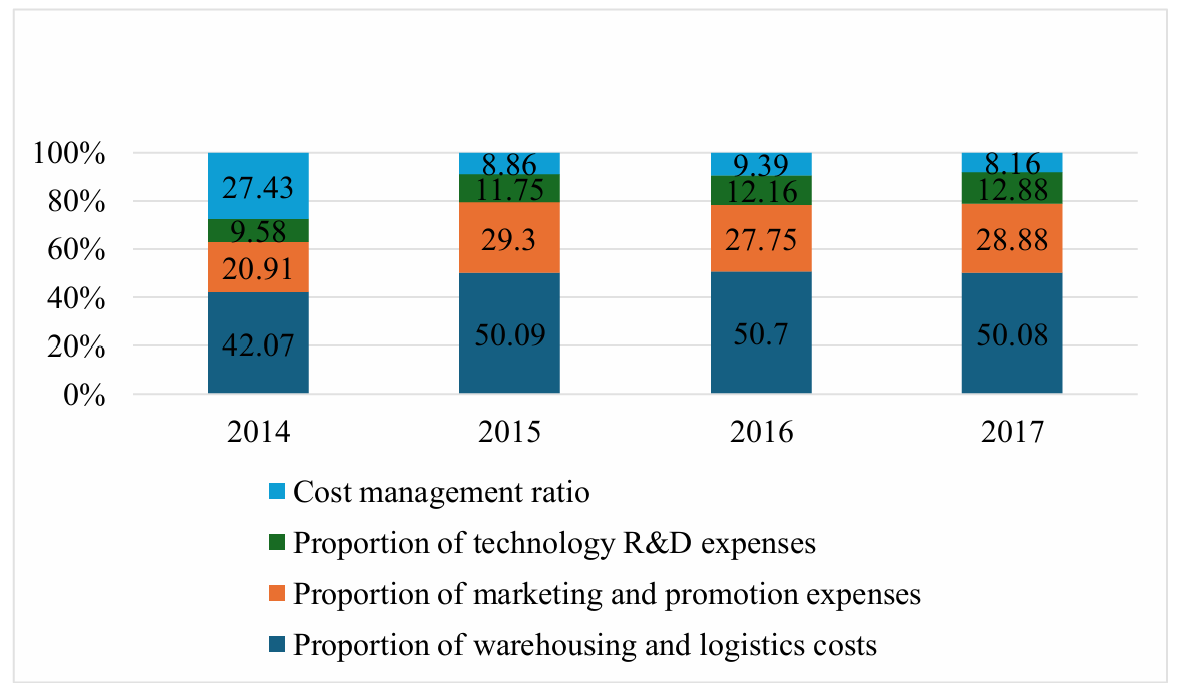1.Introduction
Although the domestic e-commerce industry starts relatively late, it develops rapidly thanks to the growing demand for online shopping. With the continuous influx of e-commerce, market competition is becoming increasingly fierce. In order to consolidate their position, e-commerce companies have started to seek to optimize the supply chain, and reducing costs is one of the keys. As an important link in the supply chain, logistics cost control is particularly critical.
JD.com occupies an important market position in e-commerce. In 2014, JD.com became China's first comprehensive e-commerce company to be successfully listed in the United States with its rich categories covering more than 30 million products. As of 2020, JD.com accounts for about a quarter of the market share in the B2C market [1]. JD.com's high share is due to its unique supply chain technology and system. JD.com's unique logistics system is the core of its strong competitiveness. By quickly responding to customer needs and calling the warehouse closest to the customer for instant delivery, JD.com achieves efficient and convenient logistics services. As of September 2021, JD.com’s warehouse network covers the whole country, including 2,200 general warehouses and 28 large-scale smart warehouses “Asia No. 1” [1]. At the same time, other technologies such as artificial intelligence, big data, and cloud computing are also used, which are of great use in sorting orders and making decisions.
However, while JD.com is developing rapidly, it also faces many challenges. The investment in building a logistics system is too large, and huge manpower and material resources are required to support the maintenance and management of warehouses. The labor cost required for the “last mile of distribution” has increased, all of which increases the company’s costs and risks. At the same time, how to improve customer satisfaction and reduce customer maintenance costs is also a key issue facing JD.com. Reducing costs can increase corporate profits and make JD.com more competitive when competing with other e-commerce platforms. How to reduce costs, increase efficiency, and use emerging technologies to reduce costs is one of JD.com’s main considerations.
Based on this, this paper mainly studies the various cost management in JD.com’s supply chain, analyzing based on tables and data, finding problems, and giving corresponding optimization strategies.
2.JD Logistics Cost Analysis
2.1.Analysis of Self-operated Logistics Cost
JD.com's self-operated logistics costs mainly include procurement costs, distribution costs, warehouse costs, and staff wages [2].
Building a huge logistics network involves multiple links such as packaging and warehousing. Each link requires a lot of financial and human resources. For JD.com, this requires a huge initial investment. Warehouses occupy a major position in JD.com's self-operated logistics model, so the main cost increase in self-operated logistics costs lies in the construction of new large-scale intelligent warehouses. As shown in Figure 1, the number of JD.com's self-built warehouses increased year by year [3]. In addition, JD.com may increase the scale of warehouses in the future, so the investment cost in warehouses will still be very high in the future. Excessive investment in warehouse facilities will make the company's cash flow ability poor and its ability to cope with economic risks insufficient.

Figure 1: Summary of JD.com’s self-built warehouses.
2.2.Procurement Cost Analysis
Procurement costs account for a large proportion of JD.com's internal costs [1]. According to Table 1, JD.com's operating income and gross profit margin increased year by year from 2011 to 2018[4]. JD.com's operating costs include procurement costs and operating expenditure costs. JD.com's sales costs do not involve the production and processing of goods, so JD.com's sales costs mainly refer to the procurement costs of goods. The procurement costs of products are affected by various factors. However, when measuring JD.com's procurement cost control, the proportion of procurement costs to operating income can be used, combined with the gross profit margin indicator to simply calculate the control effect of procurement costs. In terms of gross profit margin, it can be analyzed based on comparison with foreign companies. JD.com's gross profit margin reached a maximum of 15.16%, while Amazon's gross profit margin reached a maximum of 40.99%. At the same time, the gross profit margin difference between the two companies reached 25% in 2020 [1]. This shows that JD.com's procurement cost management should be improved, and lower cost control can be achieved through the improvement of mechanisms.
At present, in order to control procurement costs, 90% of JD.com's products are shipped directly by manufacturers by eliminating intermediaries [5]. In addition, for secondary suppliers, JD.com will conduct secondary screening by selecting lower-priced or higher-quality products to control costs. Shipping from local warehouses can reduce the cost of transporting purchased items and maintenance costs, which is also a major measure for JD.com to control procurement costs.
Table 1: Partial Profit Statement of JD.com from 2012 to 2018 (Unit: million RMB).
|
years |
2011 |
2012 |
2013 |
2014 |
2015 |
2017 |
2018 |
|
Operating costs |
21576.16 |
37,898.38 |
62,495.53 |
101,631.44 |
158,960.42 |
311,516.83 |
39606.61 |
|
Operating income |
21129.61 |
41380.52 |
69339.81 |
115002.32 |
181042.3 |
362331.75 |
46201.98 |
|
gross profit margin |
1152.73 |
3,482.13 |
6,844.27 |
13,370.87 |
22,081.91 |
50,814.92 |
6595.36 |
|
Operating expenses |
1041.96 |
6072.23 |
8183.09 |
24433.3 |
30316.8 |
55865.4 |
67309.38 |
|
Sales promotion expenses |
479.12 |
1,735.86 |
2,350.50 |
9,270.34 |
9,420.61 |
19,132.90 |
14118.35 |
|
Technology R&D expenses |
240.68 |
— |
— |
2,902.03 |
6,652.37 |
9439.83 |
|
|
Management Fees |
322.16 |
639 |
760 |
5,260.00 |
2,877.00 |
4,215.00 |
11719.23 |
|
Other operating expenses |
— |
3,697.37 |
5,072.59 |
9,902.96 |
15,117.16 |
25,865.13 |
32031.97 |
|
Net Profit |
-1140.41 |
-195.11 |
-57.88 |
-580.24 |
-535.79 |
-83.55 |
-2619.13 |
2.3.Downstream Customer Maintenance Cost Analysis
JD.com's downstream customer maintenance costs mainly lie in marketing costs and after-sales costs. To promote its products extensively, JD.com established partnerships with major Internet companies and carried out advertising and promotion through these channels. However, JD.com's promotion costs remained high. As can be seen from Figure 2, the promotion costs are increasing from 2014 to 2017, with an increase of 272.02%. Based on the trend, it is expected that the marketing costs will remain high in the future [6]. JD.com uses a variety of marketing methods, including inserting TV ads, magazine ads setting up billboards offline, and using different operating platforms for promotion online. JD.com attaches importance to personalized services and user experience optimization and pushes products that better meet the needs of customers. JD.com placed more online advertisements than other e-commerce companies, which brought JD.com good operating benefits. However, excessive placement is the main reason for the high operating costs.
In the customer satisfaction survey, JD.com's complaints accounted for 15.34%, and the feedback time efficiency was 74.34%. Compared with other e-commerce platforms, the satisfaction rate is not high, and the return rate is as high as 28% [6]. The main reason is that the monitoring mechanism is not perfect, the after-sales service is not comprehensive, and many return and exchange procedures are handled by third-party sellers, resulting in low efficiency. JD.com should improve the testing mechanism and train professional personnel to provide after-sales service, but it is expected that there will be a considerable cost expenditure.

Figure 2: JD.com's overall operating cost composition.
3.Cost Management Optimization
3.1.Reduce Storage Costs
To optimize inventory management, JD.com can make improvements in two aspects: accurate prediction and strategy optimization. First, accurate prediction capabilities are particularly important for self-operated supply chains. JD.com can determine the best time to purchase by accurately predicting future sales, warehousing needs, financial flows, and traffic. Seasonal and trend forecasts can effectively adjust inventory quantities, and promotion forecasts and promotional activities can guide replenishment quantities.
Secondly, JD.com can optimize demand planning, inventory planning, and replenishment models through the algorithm platform to improve decision-making efficiency. By integrating information such as sales forecasts, product plans, customer needs, and priorities, JD.com can formulate reasonable demand plans. At the same time, through its own logistics system, JD.com can achieve multi-level inventory regulation and balance and set reasonable turnover inventory, safety inventory, and strategic inventory based on demand plans. In addition, through model optimization, JD.com can match the most appropriate replenishment strategy for different inventory levels, and provide corresponding treatment solutions for slow-selling products, thereby ensuring the smooth operation of the business.
In order to cope with supply chain disruptions and external risks, JD.com's inventory management model adopts a full-process inventory monitoring and diagnosis mechanism, which can promptly detect potential problems, avoid risks, and ensure inventory health. Use digital technology to optimize inventory management and achieve supply chain coordination and integration [7].
3.2.Improve After-sales Service
JD.com’s after-sales service is very important to the company. Attracting and ultimately maintaining customers can ensure the future sustainability of the company’s business. Customer loyalty is the key to a company’s survival and ability to compete with its competitors in fierce competition [8]. JD.com can determine user groups based on data analysis, deeply explore user needs based on user characteristics, and then improve after-sales services that meet the needs of user groups. JD.com provides a 7-day no-reason return service, which allows users to not worry about product returns, making them feel more at ease, reducing shopping anxiety, and winning the trust of more consumers. Secondly, JD.com has a 24-hour customer service center that can respond quickly and provide customers with a variety of after-sales channels so that customers can solve problems in a timely manner. JD.com can improve after-sales efficiency and after-sales service satisfaction by recruiting and training more professional after-sales personnel. At the same time, JD.com uses artificial intelligence technology to develop an intelligent customer service system that allows customers to get timely solutions to some basic common problems. And big data can help JD.com predict and solve customer after-sales needs. JD.com can also establish corresponding repair centers to make repairs more convenient for customers, improve the efficiency of after-sales service, and make after-sales service more convenient and quicker. JD.com provides better after-sales service to JD.com Plus members, who can enjoy more convenient and longer warranty services. JD.com should safeguard the rights and interests of these members and provide better services to increase the stickiness of the member user group.
4.Smart Logistics Development
Smart logistics, as a core component of modern supply chain management, can achieve automation, visualization, intelligence, and networking of logistics systems by integrating advanced technologies such as the Internet of Things and artificial intelligence and promoting a profound transformation of corporate operations. By connecting various nodes in the supply chain, the smart logistics platform breaks down information barriers, promotes information interaction and sharing between upstream and downstream enterprises, and builds an efficient, intelligent, and stable supply chain collaborative development system.
With the further development of information technology, JD.com partially solved the problems of future sales, warehousing needs, and optimal procurement timing by using its own infrastructure and powerful algorithm platform. However, it also faces huge pressures in capital, management, and algorithm optimization [7].
By building its own logistics system, JD.com can achieve multi-level inventory control and balance and set reasonable turnover inventory, safety inventory, and strategic inventory according to demand plans [9]. JD.com's dedicated sensors collect data in real-time and transmit it to the computer system. The system then analyzes the data and makes decisions. The data is stored, and the route planning is continuously improved through algorithms. The Internet of Vehicles enables vehicles to exchange data with surrounding objects or specific transportation infrastructure by equipping cars with sensors, processing power, and network connections. Through the connection, transportation vehicles and infrastructure can exchange information. The main goals of adopting an intelligent transportation model are to ensure efficient delivery management, reduce operating costs, increase accountability, and improve consumer satisfaction through better service.
JD's inventory management model adopts a full-process inventory monitoring and diagnosis mechanism, which can timely detect potential problems, avoid risks, and ensure inventory health. Digital technology is used to optimize inventory management and achieve supply chain coordination and integration [9]. However, JD's warehouse management system must overcome many management and control challenges, including inventory tracking, space management optimization, and rapid order processing. Several factors may affect the above challenges, the most prominent of which are the increase in personalized customer orders and the huge order volume of large-scale discount events such as "Double Eleven". To cope with these problems, management practices and procedures must be strengthened. The combination of administrative management and technological innovation is necessary for the transformation of traditional warehouse management systems (WMS) to cyber-physical systems (CPS-WMS). These innovations include optimizing the selection of CPS methods, integrating environmental information, timely transmission of data flows, and improving processing speed [10]. Through these improvements, intelligent logistics can more efficiently respond to rapidly evolving market demands and provide customers with more accurate and timely services.
At present, the development of smart logistics (SL) in China as a whole and in most provinces is close to the ideal level. The eastern region is far ahead, the central region is developing relatively steadily, and the western and northeastern regions are showing a declining trend, with great pressure for optimization. Although the driving force of China's smart logistics is significantly enhanced and the development pressure is alleviated, there is still a lot of room for improvement [11]. In the future, the development status of smart logistics will play a key role in the overall progress of JD.com and provide strong support for its logistics cost management optimization.
5.Conclusion
This study deeply explores the optimization of logistics cost management of JD.com from the perspective of the supply chain. The results show that although the establishment of JD.com's self-operated logistics system brought significant operational advantages, its huge initial investment and continuous cost growth weakened JD.com's ability to cope with economic risks to a certain extent. In terms of procurement costs, although JD.com achieved direct cooperation with manufacturers, its procurement cost management effect still has a lot of room for improvement compared with advanced foreign companies. Although marketing achieved good results in downstream customer maintenance costs, excessive investment kept costs high, and appropriate investment should be made in the future. JD.com's customer satisfaction needs to be improved because the monitoring mechanism after-sales service is not perfect, and there will be considerable expenditure in order to improve it. How to balance is also a problem that JD.com needs to consider.
In terms of cost management optimization, JD.com reduces warehousing costs through accurate prediction and strategy optimization, and at the same time makes the entire supply chain run more smoothly. Through the current areas where JD.com needs to improve after-sales service, improvement methods are proposed, and new strategies and methods are proposed to make after-sales service more perfect and customers more satisfied and stable.
Finally, JD.com applies smart logistics to visualize all aspects, making inventory and logistics easier to regulate and increasing the overall efficiency of the supply chain. However, although JD.com applies many emerging technologies, it still faces many challenges and room for improvement in supply chain management. Therefore, in the future, JD.com should continue to increase the application of smart logistics and continuously develop new technologies to further optimize logistics costs and promote the development of the entire supply chain. Although this study conducted some analysis and provided solutions, there are some limitations in data collection and research methods, which may affect the applicability of the conclusions.



